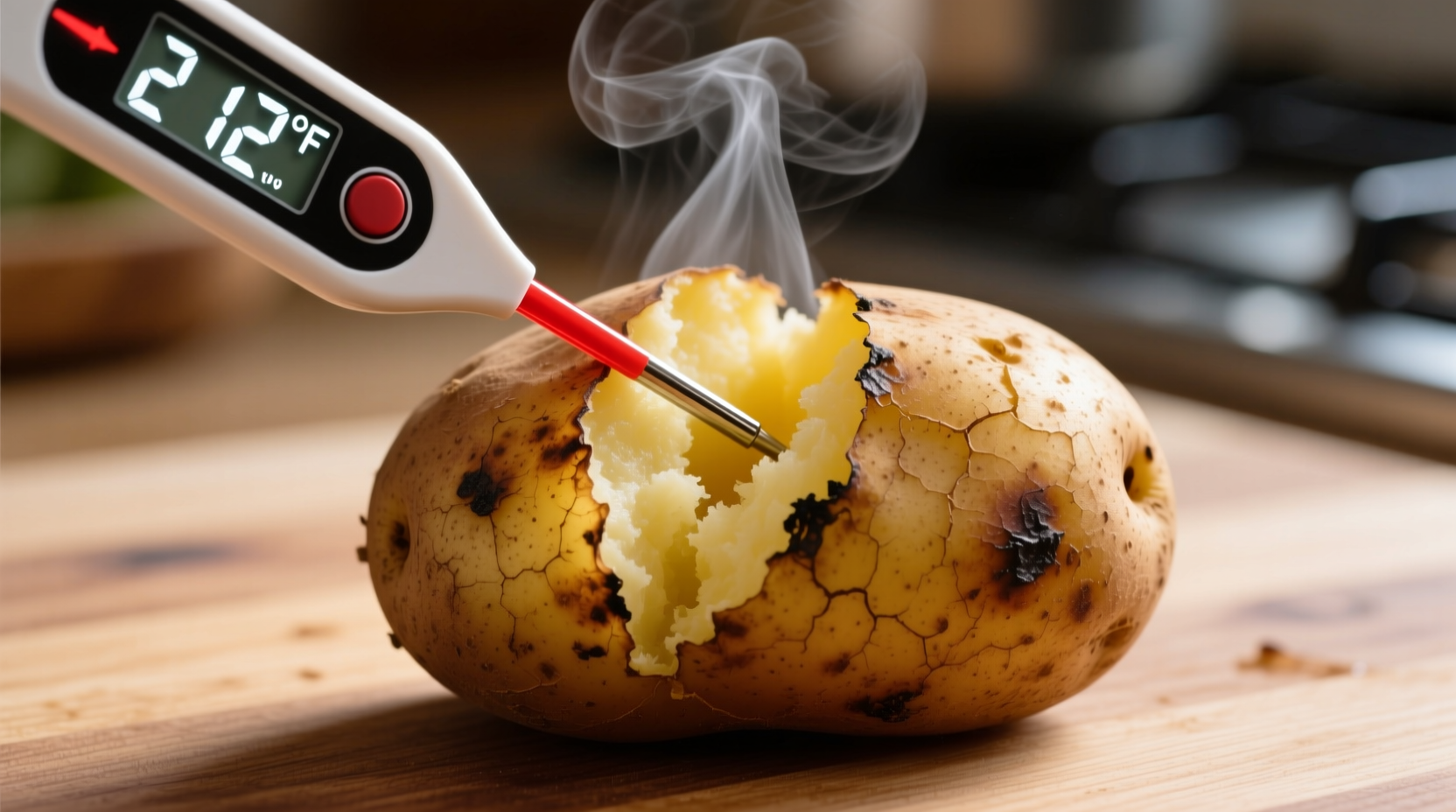The ideal internal temperature for a perfectly cooked baked potato is 205-210°F (96-99°C). For optimal results, bake potatoes at 400-425°F (204-218°C) for 45-60 minutes depending on size.
Nothing beats the comforting simplicity of a perfectly baked potato with fluffy interior and crisp skin. But hitting that sweet spot between undercooked and overdone requires understanding both oven settings and internal temperature. This guide delivers science-backed temperature insights that guarantee restaurant-quality results every time.
Why Temperature Matters for Baked Potatoes
Temperature control transforms starchy tubers into culinary perfection. When potatoes reach 205°F internally, their starch granules fully gelatinize, creating that signature fluffy texture. Below this threshold, potatoes remain dense and undercooked. Exceeding 210°F risks drying out the interior. The USDA's Food Safety and Inspection Service confirms that while potatoes aren't high-risk like meats, proper cooking ensures optimal texture and eliminates any potential surface bacteria.
| Temperature Type | Optimal Range | Resulting Texture |
|---|---|---|
| Oven Temperature | 400-425°F (204-218°C) | Crisp skin, even cooking |
| Internal Temperature | 205-210°F (96-99°C) | Fluffy, fully cooked interior |
| Undercooked | Below 195°F (90°C) | Dense, hard center |
| Overcooked | Above 215°F (102°C) | Dry, crumbly texture |
Mastering the Baking Process: From Oven to Table
Preparation: Setting the Stage for Perfect Cooking
Start with uniform russet potatoes of similar size for even cooking. Pierce each potato 4-5 times with a fork to allow steam to escape—this prevents bursting. Contrary to popular belief, skipping the oil rub before baking preserves the skin's crispness. The University of Minnesota Extension confirms that oil creates a barrier that steams rather than bakes the skin.
Optimal Baking Conditions
Place potatoes directly on the oven rack with a baking sheet on the lower rack to catch drips. For consistent results:
- Small potatoes (5-6 oz): 400°F for 40-45 minutes
- Medium potatoes (8-10 oz): 400°F for 50-55 minutes
- Large potatoes (12+ oz): 400°F for 55-60 minutes
For faster cooking without sacrificing texture, increase to 425°F and reduce time by 10-15 minutes. America's Test Kitchen research shows this higher temperature creates superior crispness while maintaining fluffy interiors.
Accurate Temperature Verification
Don't rely solely on cooking time—always verify internal temperature. Insert an instant-read thermometer into the thickest part of the potato, avoiding the center where heat concentrates. The ideal reading is 205-210°F. At this temperature:
- Starches have fully absorbed moisture and expanded
- Cell walls have ruptured sufficiently for fluffy texture
- Residual heat will carry temperature to 212°F during resting

Troubleshooting Common Temperature Issues
Hard Center Despite Long Cooking Time
This indicates uneven heat distribution. Try these fixes:
- Rotate potatoes halfway through baking
- Avoid overcrowding on baking sheet
- Place potatoes on a preheated baking steel for bottom heat
Soggy Skin
Caused by trapped moisture. Prevent this by:
- Drying potatoes thoroughly before baking
- Skipping oil during initial baking (add after)
- Finishing with 5 minutes under the broiler
Food Safety Considerations
While potatoes aren't high-risk like meats, proper handling matters. The FDA Food Code recommends holding cooked potatoes above 135°F if serving buffet-style to prevent bacterial growth. Never leave baked potatoes at room temperature for more than 2 hours. For meal prep, cool rapidly in the refrigerator and consume within 3-4 days. The USDA Food Safety and Inspection Service emphasizes that proper temperature control prevents potential Clostridium botulinum growth in improperly stored cooked potatoes.
Advanced Temperature Techniques
For next-level results, try these professional methods:
- Reverse sear method: Bake at 325°F until 195°F internal, then finish at 450°F for 10 minutes for ultra-crisp skin
- Steam finish: Wrap in foil for final 10 minutes to create restaurant-style fluffy texture
- Convection boost: Use convection setting at 375°F for 25% faster cooking with even browning
Frequently Asked Questions
What's the minimum safe internal temperature for a baked potato?
While potatoes aren't subject to strict food safety temperatures like meats, they should reach at least 195°F (90°C) to ensure complete cooking. The ideal range is 205-210°F (96-99°C) for perfect texture. Below 195°F, starches remain under-gelatinized, resulting in dense, hard centers.
Can I bake potatoes at 350°F instead of 400°F?
Yes, but with trade-offs. At 350°F, baking time increases to 65-75 minutes. While this lower temperature reduces the risk of burnt skin, it creates less crisp exterior and can yield denser interiors. Food science research shows the Maillard reaction (responsible for browning and flavor development) occurs most effectively between 300-450°F, making 400°F the optimal balance for baked potatoes.
How do I check temperature without a thermometer?
Without a thermometer, use these reliable indicators: the potato should feel soft when gently squeezed (using oven mitts), a fork should slide in with no resistance, and the skin should appear slightly wrinkled. For russets, the internal temperature correlates with visual cues - when the skin pulls away slightly from any cuts, it's typically reached 205°F. However, an instant-read thermometer remains the most accurate method.
Why does my baked potato temperature vary throughout?
Temperature variation occurs due to uneven heat distribution in home ovens (typically 25-50°F fluctuations) and potato density differences. The center heats slower than edges, creating a temperature gradient. This is why inserting the thermometer off-center but away from the core gives the most accurate reading of fully cooked flesh. Rotating potatoes halfway through baking minimizes this variation.











 浙公网安备
33010002000092号
浙公网安备
33010002000092号 浙B2-20120091-4
浙B2-20120091-4